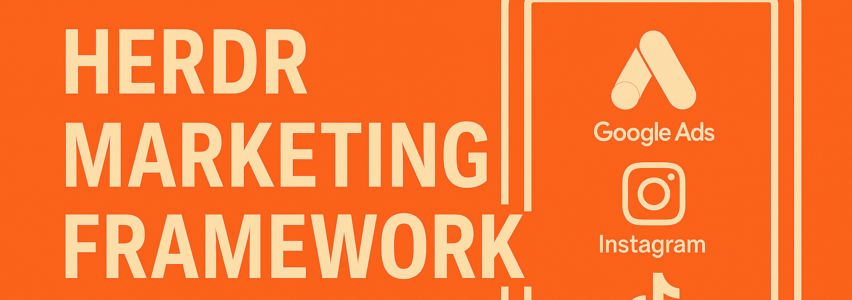The Herdr Marketing Framework

A Practical System for Building a Brand and Driving Traffic Across Google Ads, Instagram, TikTok, LinkedIn, YouTube, and Your Blog
Small, modern businesses—especially startups and solo teams—need a clear, connected marketing system to stand out. The Herdr Marketing Framework is a channel-agnostic approach that helps teams build a memorable brand and generate consistent traffic to their site using five major platforms: Google Ads, Instagram, TikTok, LinkedIn, YouTube, and a content-driven blog.
This framework is designed to work with limited resources, move fast, and compound over time.
🎯 Core Principles of the Herdr Framework
- One Brand, Many Channels
Your brand should feel consistent and recognizable across all touchpoints—but tailored to each platform’s culture. - Content + Distribution
Great content means nothing without eyeballs. Paid and organic traffic must work together. - Fast Feedback Loops
Test, learn, iterate—don’t overinvest until something works. - Strategic Simplicity
Start with the channels that align with your target buyer and keep each step minimal but intentional.
🔖 Part 1: Building Your Brand Identity
Before anything else, clarify:
- Who are you helping?
- What pain do you solve?
- Why are you different?
- What do you stand for visually and verbally?
Deliverables to complete:
- Logo, brand colors, and typography
- Voice and tone guide (e.g. friendly, bold, direct)
- One-liner that explains your value
- 3–5 brand pillars or core beliefs
Use this identity consistently in all content, ads, bios, thumbnails, and landing pages.
📈 Part 2: Drive Immediate Traffic with Google Ads
Google Ads gets you intent-driven traffic right now. It’s your lowest funnel channel.
Strategy:
- Start with branded search and pain-point keywords (e.g., “project management for remote teams”)
- Avoid broad match; start with phrase or exact match
- Use dedicated landing pages that match each keyword group
Tactics:
- Use callout extensions for credibility
- A/B test 2–3 headlines per ad group
- Track conversions and quality using UTM parameters + Google Analytics
How it fits:
Google Ads delivers high-intent traffic while your brand is still gaining organic traction. Feed the traffic to blog posts, lead magnets, or feature-focused pages.
📸 Part 3: Build Brand & Social Proof on Instagram
Instagram helps shape perception and showcase brand depth. Think of it as your visual credibility deck.
Strategy:
- Focus on content pillars: behind-the-scenes, product visuals, user stories, team culture
- Post 3–4x per week with one high-effort carousel or Reel per week
Tactics:
- Use Stories for raw, in-progress moments
- Link to blog posts, feature pages, and Shorts
- DM new followers with a helpful free resource
How it fits:
Instagram builds brand warmth and supports retargeting ads from Google or TikTok traffic.
🎥 Part 4: Create Demand and Awareness on TikTok
TikTok is an attention machine that favors storytelling, humor, and insight. It’s perfect for top-of-funnel visibility.
Strategy:
- Make your founder or team the face of the brand
- Use trends to insert your product into popular formats
Tactics:
- Post 1–2x daily, even if simple
- Use captions and hook-first structure (“3 things I wish I knew before…”)
- Add a link-in-bio (via Linktree or direct)
How it fits:
Use TikTok to create awareness and send interested viewers to Instagram, YouTube, or your blog. It’s your demand engine.
💼 Part 5: Establish Authority on LinkedIn
LinkedIn builds trust and credibility in professional spaces. It’s ideal for B2B products, founders, and thought leadership.
Strategy:
- Personal account first, then company page later
- Share real lessons, failures, customer stories, or process breakdowns
Tactics:
- Post 3x weekly with 1 post repurposed from your blog
- Use simple text + emoji formatting
- Engage in comments on others’ posts in your niche
How it fits:
LinkedIn drives high-trust, professional awareness and can warm up cold leads for outbound or retargeting.
🎬 Part 6: Capture and Educate on YouTube
YouTube is your evergreen education platform and long-term SEO asset.
Strategy:
- Focus on tutorials, case studies, and comparisons (e.g., “ClickUp vs. Trello for remote teams”)
- Use Shorts to test ideas and push to long-form
Tactics:
- Batch-record 4–6 videos per month
- Optimize titles, thumbnails, and retention
- Add CTAs to blog content and free tools in the description
How it fits:
YouTube boosts SEO, builds deep trust, and feeds traffic to your blog, landing pages, or product signups.
✍️ Part 7: Build a Blog That Powers Everything
The blog is your content engine and SEO flywheel.
Strategy:
- Build clusters of 5–10 posts per topic (e.g., “Remote Team Tools” or “Startup Project Management”)
- Balance keyword-driven posts and narrative content
Tactics:
- Use keyword tools like Ahrefs, Ubersuggest, or Google Search Console
- Embed YouTube videos, link to Shorts, and summarize TikTok ideas
- Repurpose blog posts into LinkedIn and Instagram content
How it fits:
The blog is the hub: ads drive to it, social promotes it, YouTube builds on it, and it compounds over time.
🔄 Putting It All Together
| Channel | Purpose | Key Outcome | Links To |
|---|---|---|---|
| Google Ads | Capture intent | Conversions | Blog, landing pages |
| Brand & nurture | Engagement, DMs | Blog, lead magnets | |
| TikTok | Awareness engine | Top-of-funnel traffic | Blog, YouTube, Instagram |
| Trust & authority | Inbound leads | Blog, product pages | |
| YouTube | Education & SEO | Organic traffic | Blog, landing pages |
| Blog | Hub content | Leads & search traffic | All other channels |
🧠 Final Thoughts
The Herdr Marketing Framework is not about doing everything. It’s about doing the right things in sync, with content and distribution working together.
Start with 1–2 core channels, connect them to your blog, and build a sustainable loop:
- Create → Distribute → Engage → Learn → Repeat
That’s how small teams grow big brands—and traffic that converts.







